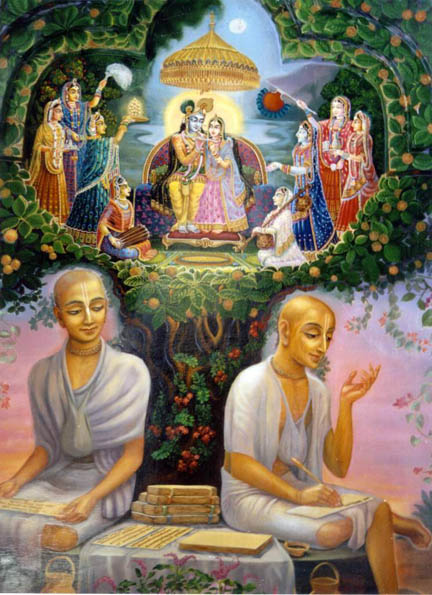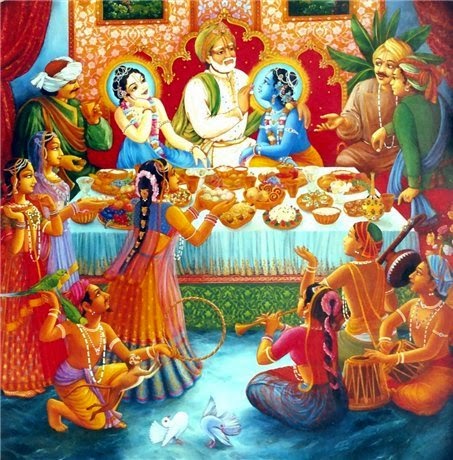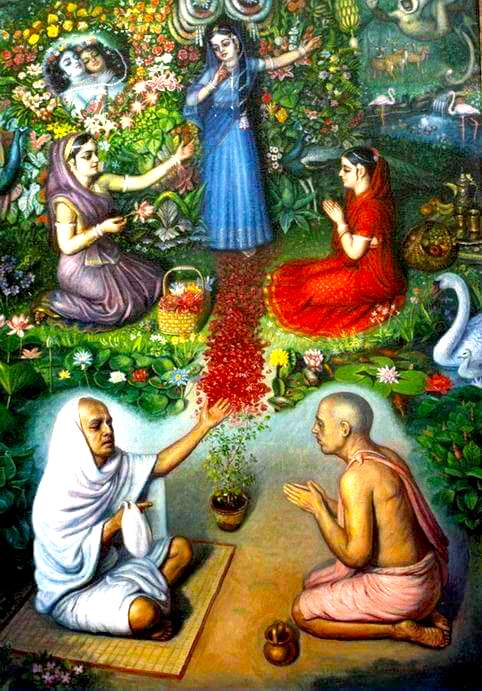Mahanidhi Madan Gopal Das
INTRODUCTION TO PURUSOTTAMA MONTH:
Purusottama month or adhika masa (extra month) is also called mala masa, which means the dirty or useless month. In India, the sadhus, sadhakas and pious people of all sampradayas undertake serious penances (vratas) during Purusottama Month. Now let us examine the name, history, benefits and method of practice of this age old “King of All Vratas” or month long penances.
WHY IS IT CALLED MALA MASA? (dirty or useless month)
This is because all forms of karmic activities i.e. karma-kanda (reward seeking) pujas and yagnas will not produce any results this month. Therefore, it is a useless month. Gaudiya Vaisnavas say the dirt or filth indicated by the word mala refers to the fact that devotional activities performed in this month quickly and easily destroy the mental dirt, filth and contamination caused by sins, ignorance and aparadhas. Thus for Krishna bhaktas this is the most purifying and beneficial month.
WHY IS IT CALLED ADHIKA MAS? (extra month)
It is called adhika (extra) masa because Sri Krishna has placed not only extra but ALL HIS potencies, mercy and blessings in this month, which supercharges this month beyond all others. Thus a sadhaka will receive extra or more results from any religious actions performed.
WHAT MAKES THIS MONTH SO GREAT?
The Puranas say that Purusottama Month is the favorite month of Bhagavan Sri Krishna. Sri Krishna personally created this month and named it after Himself. Purusottama Month, which only comes once every 36 months, is the most powerful spiritual reward giving month among all the months.
It is far superior to the pious months of Magha, Vaisakha and Karttika. On the earth planet and all over the universe the Purusottama Month is honored and worshiped by devotees, sages, gods and Laksmi Devi Herself.
BENEFITS OF PURUSOTTAMA MONTH VRATA
Different months of the year have different ista-devatas, worshipable Personalities. But for Adhika Month, Radha-Krishna Yugala are the ista-devatas. If one sincerely worships Radha and Krishna in Purusottama month, he will attain whatever he wants. Observing the Purusottama vrata burns up the reactions of all one’s bad karma and gives the direct service of Radha and Krishna.
Purusottama month is the best month to make spiritual advancement because Krishna overlooks all aparadhas. Residence in the holy dhama in this month yields 1000 times the benefit of living elsewhere!!! We invite all the fortunate to quickly book a room in Radha Kunda or Vrindavana to worship Radha-Krishna Yugala in the prema giving holy abode of Sri Vrindavana Dhama.
Come and join the thousands of pilgrims doing dandavat parikrama of Giri-Govardhana this month!!! Giriraj Dharan ki jai! Jai Jai Sri Radhe!
THE GLORIES OF PURUSOTTAMA MONTH
All quotes come from the Padma and Skanda Purana.
1. Bhagavan Sri Krishna: “Purusottama Month has all the power I have to bless its observer. One who follows Purusottama vrata will destroy all his past sinful reactions. Without performing Purusottama vrata, one cannot perform pure devotional service.
The value of Purusottama month is far more valuable than all other types of austerities and religious activities mentioned in the Vedas. Anyone who observes Purusottama vrata will go to My abode, Goloka, at the end of his life.”
2. Durvasa Muni: “One becomes sinless just by bathing in a holy river during Purusottama Month. The glory of all other months is not equal to one-sixteenth of the glory of the Purusottama Month. Bathing in a holy place, giving charity and chanting the Holy Names of Krishna during Purusottama Month destroys all miseries, awards all kinds of perfection and fulfills all desires.”
3. Valmiki Muni: “Observing Purusottama vrata brings more benefit than performing one hundred horse sacrifices. All holy places live within the body of an observer of the Purusottama Month vrata. Anyone who faithfully performs Purusottama vrata will go to Goloka Vrndavana”.
4. Narada Muni: “Purusottama Month is the best of all months, vratas and austerities. Just by faithfully hearing the glories of Purusottama Month, one attains Krishna-bhakti and immediately nullifies his sinful reactions. One who performs Purusottama vrata properly will attain unlimited piety and spiritual merit (sukrti) and go to the spiritual world.”
5. Naimisaranya Sages: “Merciful Purusottama Month acts like a desire tree to fulfill a devotee’s desire.”
HOW TO OBSERVE THE PURUSOTTAMA MONTH VRATA
General points: Observe celibacy and bathe daily before sunrise; chant extra rounds and read Srimad Bhagavatam daily; give charity.
1. Rise at brahma-muhurta (1½ hours before sunrise), and jump out of bed chanting “Jaya Radhe!”
2. Chant Hare Krishna Mahamantra and meditate on Radha-Krishna’s beautiful divine forms, qualities, and ecstatically purifying and heart stirring transcendental pastimes in Sridhama Vrndavana. Daily chant fixed number extra rounds for entire month: 4, 8, 12, 16, 20, 24, 32, 64, 108, 192 (always multiples of four rounds).
3. Observe the Vrata in Vrndavana, Navadvipa or any holy dhama to experience the maximum benefits and bliss.
4. Daily offer full puja or at least a ghee lamp to Radha-Krishna Deities or picture. Offer a row of 33 individual clay ghee lamps daily, or at least for one auspicious day this month e.g. (ekadasi, sankranti, purnima etc).
5. Daily Tulasi Devi aratika and parikrama.
6. Daily Thakuraji Mandira parikrama (4 times).
7. Daily offer roses, lotus, and tulasi manjaris and 100,000 Tulasi leaves (or as many as you can) to Radha-Krishna Deities or photos and paintings.
8. Daily read Srimad Bhagavatam.
9. Hear Radha-Krishna Katha from advanced Gaudiya Vaisnavas.
10. Daily chant Sri Jagannathastakam (because this vrata is named after and often performed in Purusottma Ksetra Jagannatha Puri Dhama. Also chant astakams, prayers and bhajans glorfying Radha-Krishna Yugala.
11. Take a vow to remain peaceful and 100% truthful throughout the month.
12. Be careful not to blaspheme any devotees, brahmanas, saints, cows, sastras or especially anyone observing the Purusottama Month Vrata.
13. Don’t ask anyone for anything; be satisfied with whatever you have, and don’t endeavor to acquire any material thing during this month.
14. Try your best to please Radha and Krishna by performing devotional austerities according to your abilities. Don’t break your vow in the middle of the month. Be determined, pray intently for mercy and tolerate your crazy monkey mind. Take a vow, at least for this month, to remain deaf to your mind.
15. Eat on leaf plates sitting on the floor (optional).
16. No cutting of hair or nails (optional).
17. No cooking in oil or rubbing oil on your body.
18. Don’t eat mustard oil nor rub on the body.
Diets: Be your own guide and choose an eating program that is realistic within your means. The main vrata and austerity is to everyday Krishna consciously associate with serious devotees in Vrndavana who are glorifying Radha-Krishna
************If you can, it is best to EAT ONCE A DAY after sunset or at noon the following diets:
i) only milk; ii) only fruits (no milk, no veg.); iii) no grains (selected veg., fruits, nuts, milk); iv) selected foods (all categories as per caturmasya standards).
A NICE HUMILITY VRATA: Daily offer 33 dandavats to Bhagavan Sri Krishna and/or the Vaisnavas.
SRILA BHAKTIVINODA THAKURA’S Purusottama Month VRATA:
Observe 30 days of concentrated, one–pointed worship and service to Radha-Govinda Yugala by hearing, chanting, remembering Their divine names, forms, qualities, pastimes, and honor Sri Krishna’s Mahaprasada.
BEST DAYS TO GIVE CHARITY TO DEVOTEE BRAHMANAS:
Ekadasi, Dvadasi, Purnima, Amavasya, Sravana Naksatra Day; DO offer money, gold, cloth, shoes, fruits, etc. Also offer 33 plantains or mangos plus dana and dakshina to Brahmanas and Vaisnavas.
Very Important Point: When you give dana (i.e. diff. items like cloth, land, gold, cows, books, sweets, flowers, clothing, shoes, umbrellas) to a brahmana, one must simultaneously donate dakshina (i.e. money equal to the monetary value of the dana). For example, if give a 300 rupees pair of new shoes, then must give 300 rupees in laksmi or money to that same person.
BREAKING THE PURUSOTTAMA VRATA
1. Day and Time: consult local calendar.
2. Bathe in brahma-muhurta time
3. Perform Deity Worship: Radha-Syamasundara Deities, personal Deities or Picture.
4. Chant this mantra: “O Supreme Lord, O Sanatana, O Purusottama, O Lord Hari! I offer my obeisances unto you. May you and your beloved Radhika, please accept my offerings. I offer my repeated obeisances unto Syamasundara, who wears effulgent yellow garments on His beautiful body.
5. Offer pushpanjali (handfuls of fresh fragrant flowers or petals) and then dandavats to your personal Deities or Deity Picture.
6. Feed and give charity to 3, 5, 7, 9, 11 brahmanas/ Vaisnavas to the best of your ability (e.g., new clothes, two pairs of shoes, umbrella, ghee, yogurt, gumsas, sweets, lotas, plates. Also donate money equal to cost of given item (ie If give Rp. 300 box of sweets, then also give Rp. 300.
***According to Puranas, the best charity is to give a Srimad Bhagavatam to a qualified grhastha vaisnava brahmana. This act will deliver all your ancestors to the spiritual world and award them the association of Lord Purusottama!***
SPECIFIC VRATA BREAKING ACTIONS
If you ate fruits, ghee, rice, wheat etc., donate the same to brahmanas.
If you slept on the floor, give a bed and pillows to a brahmana.
If you ate on a leaf plate, feed brahmanas with ghee and sugar.
If you didn’t cut nails or hair, donate a mirror to a brahmana.
If you offered ghee lamps, give new lamps and pots to a brahmana
***If you broke any rules or regulations during Purusottama vrata, feed different sweet juices to brahmanas.
***Mahadeva Lord Siva says that the best charity is to: “Fill a bell metal pot with thirty malpuas (a pancake like sweet), bind the pot with seven new threads and give to a worthy brahmana.”
Comment: many humble niskincana Vaisnavas have no money or sufficient wealth to donate substantially to brahmanas. But according to your means, donate some laksmi or a new object to a qualified person, begging for his mercy and blessings. And in your mind, (manasi-seva), you can sincerely donate generously to many good devotees.
Remember that shastras say, bhava grahi janardana, Bhagavan Sri Krishna is pleased with the purity and sincerity of one’s attitude, mood of love and purity of purpose. Try your best to break your vow by donating something within your means.
May Giridhari Syama bless you all with full success in your Purusottama Month Vrata, being performed solely for the divine pleasure of Sri Guru, Gauranga and Sri Sri Radha and Krishna.
Purusottama month vrata ki jai!
Jai Jai Sri Radhe!



